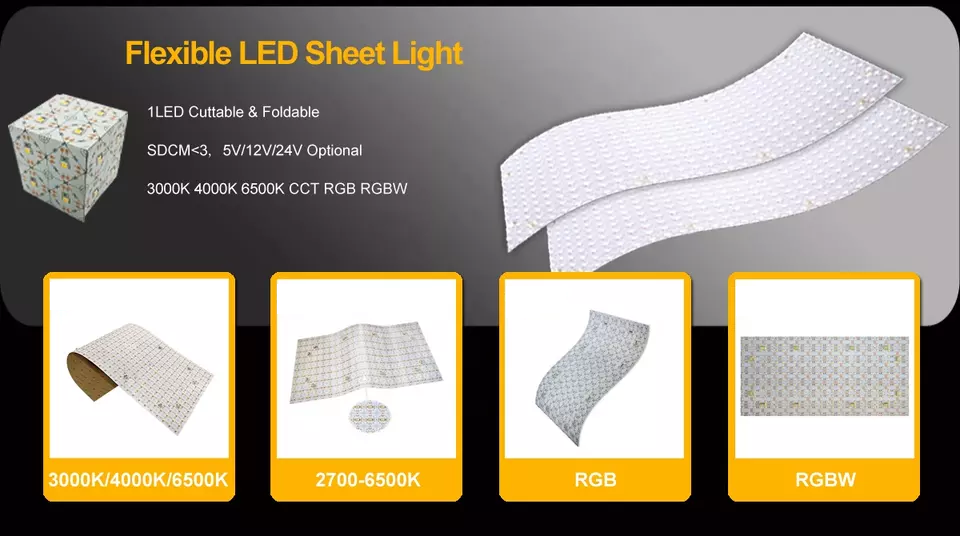LED light panels are one of today’s best and most reliable LED lighting solutions for retail design, LED POP displays, architectural signage, menu boards, interior décor, fixtures, backlit graphics, exhibitions and more. From being brighter to highly energy efficient the advantages of a LED light panel are numerous and the reasons why companies are switching to LED light panels are unrivaled.
Light Panel Basics
A LED light panel can be custom made to your specifications; preferred brightness, color temperature, shape, size, and thickness.
A LED light panel is made of optical grade clear cell cast PMMA acrylic, contain an evenly spread laser engraved dot matrix across the surface of the acrylic, LED strips, optional light diffusion film, and reflector.
Let’s now take a look an in-depth look at the components used to make a light panel guide.
- PMMA Cell Cast Acrylic
PMMA Cell Cast Acrylic are exceptionally translucent and extremely weather resilient. Because of its 96% optical clarity, this kind of acrylic has higher light transmission rates than glass. Due to its clarity LED light can be evenly distributed across the entire LED light panel creating a total curtain of even-lit light.
Because CNC Sawing and CNC Milling machines are cheaper to purchase and maintain many companies utilize these technologies to cut the acrylic for LED Light Guide Panels. The cut quality and accuracy of these machines are adequate but leave acrylic chippings/dust and leave a semitransparent edge finish on the acrylic. This restricts the LED light flow taking away from the total brightness of a LED light panel.
For high-performing acrylic, laser cutting machines are the industry standard for fast and exact cutting of acrylic. When using a laser machine, you have maximum flexibility with cut designs and can quickly cut multiple acrylic sheets.
Because the acrylic edges are laser cut the finish is crystal clear and contains no chippings or dust. This enables for 100% LED light flow across the acrylics edges.
- Laser Engraved Dot-Matrix Patterns
Silk Screen Printing and CNC V-Cutting are the most popular methods of applying Dot or Line patterns across the acrylic surface. Because CNC Cutting or Silk Screen Printing is limited on optimizing the matrix pattern the LED light distribution can vary greatly due to the machine used and experience of the fabricators using the machine.
Also, the set-up and production times for CNC and Silk Screening range from 2-4 weeks. In general CNC and Silk Screen Printing technologies for applying dot or line patterns to a LED light panel’s acrylic generate moderate – average result.
Laser engraving machines generate a superior dot or line pattern for light distribution. Because the laser machine is controlled with computer software, you have total control of the pattern size, space, dot depth and shape of a pattern.
Once you have a dot or line pattern that is thoroughly tested and optimized for 100% light distribution you can easily and quickly apply the matrix. This allows for quick lead times, even-lit distribution of light, and a highly dependable LED light panel.
- LED’s
Many companies source LED strips from online vendors to receive discounted pricing but the overall brightness, reliability, and life of the LED strips are inconsistent, and the quality significantly fluctuates.
Because LED’s are manufactured by millions per batch, the quality level per LED can greatly vary. To warrant the quality of a LED strip, it is essential that you purchase Tier 1 ANSI Binned LED’s.
ANSI (American National Standards Institute) Binned LEDs is a standardized testing process of LED’s that are required by ENERGY STAR®, the Lighting Facts™, and the Designlights Consortium. The color or CCT, lumen output and forward voltage of every LED is tested. Tier 1 represents Tier 1 Supplier.
- Finish Options
The two most popular LED light panel finishes are J-Channel and Crystal. The Crystal finish allows for a variety of custom shape LED light panel designs however heat management can be a concern. An increase in heat can significantly shorten the life of LEDs. When inserting LED’s inside of an acrylic panel, you can encounter the following issues:
- Because the aluminum extrusion used in a crystal finish is much smaller the heat management that aluminum provides is minimal
- The inside area that the LEDs are mounted is restricted and can potentially heat up much quicker
The J-Channel finish offers a superior solution for heat management, prolonging the life of your LEDs. Also, a J-Channel offers a protected base for mounting the LED strips, diffusion, and reflection film to the LED light panel. This finish produces a better built, longer lasting LED light panel.
Conclusion
Not every LED Light Panel is made the same. The engineering/design process involved and the materials being used can significantly affect the visual lighting output of the LED Light Guide Panel. When searching for an LGP make sure you understand the manufacturing process and receive up-front answers from manufactures.
At Lightpanel (USA) Inc we provide our customers with honest answers and a consultative approach towards projects. We use only the highest grade materials and world-class manufacturing technologies. We have over 30+ years in LED Light Guide Panel manufacturing experience and take pride in offering our customers a premium LGP that is brighter and entirely even-lit.
It’s simple.
Our motto is “A DIfference That You Can See”.
With that being said we encourage and invite you to order a free LED light panel sample today.





Leave A Comment
You must be logged in to post a comment.